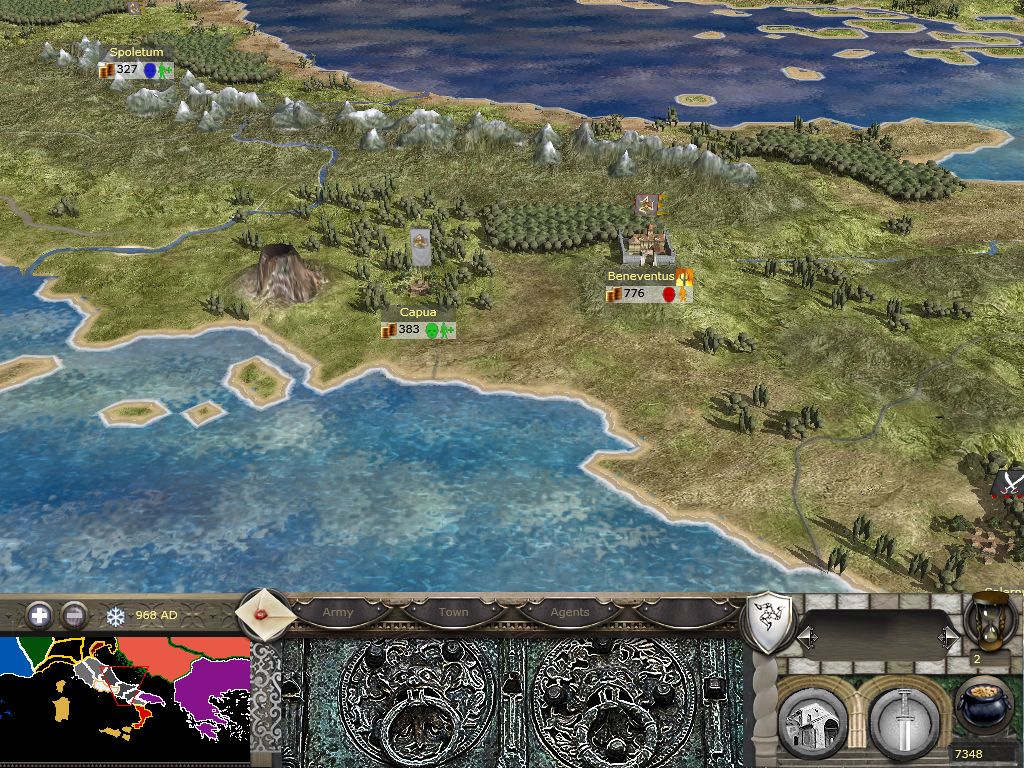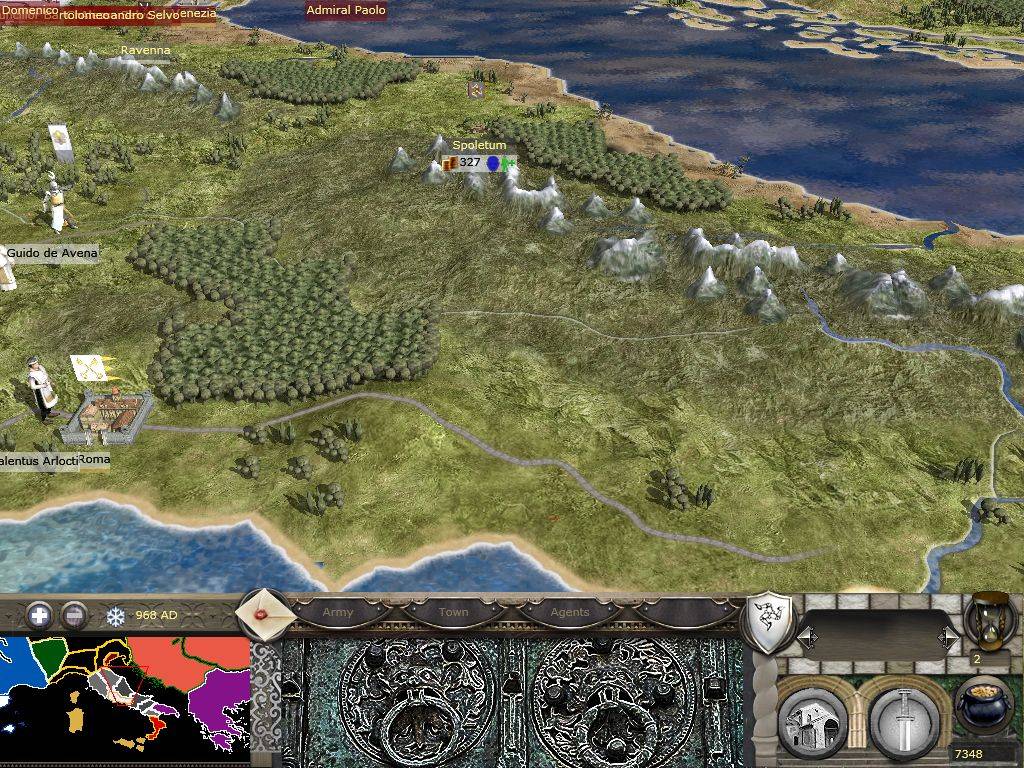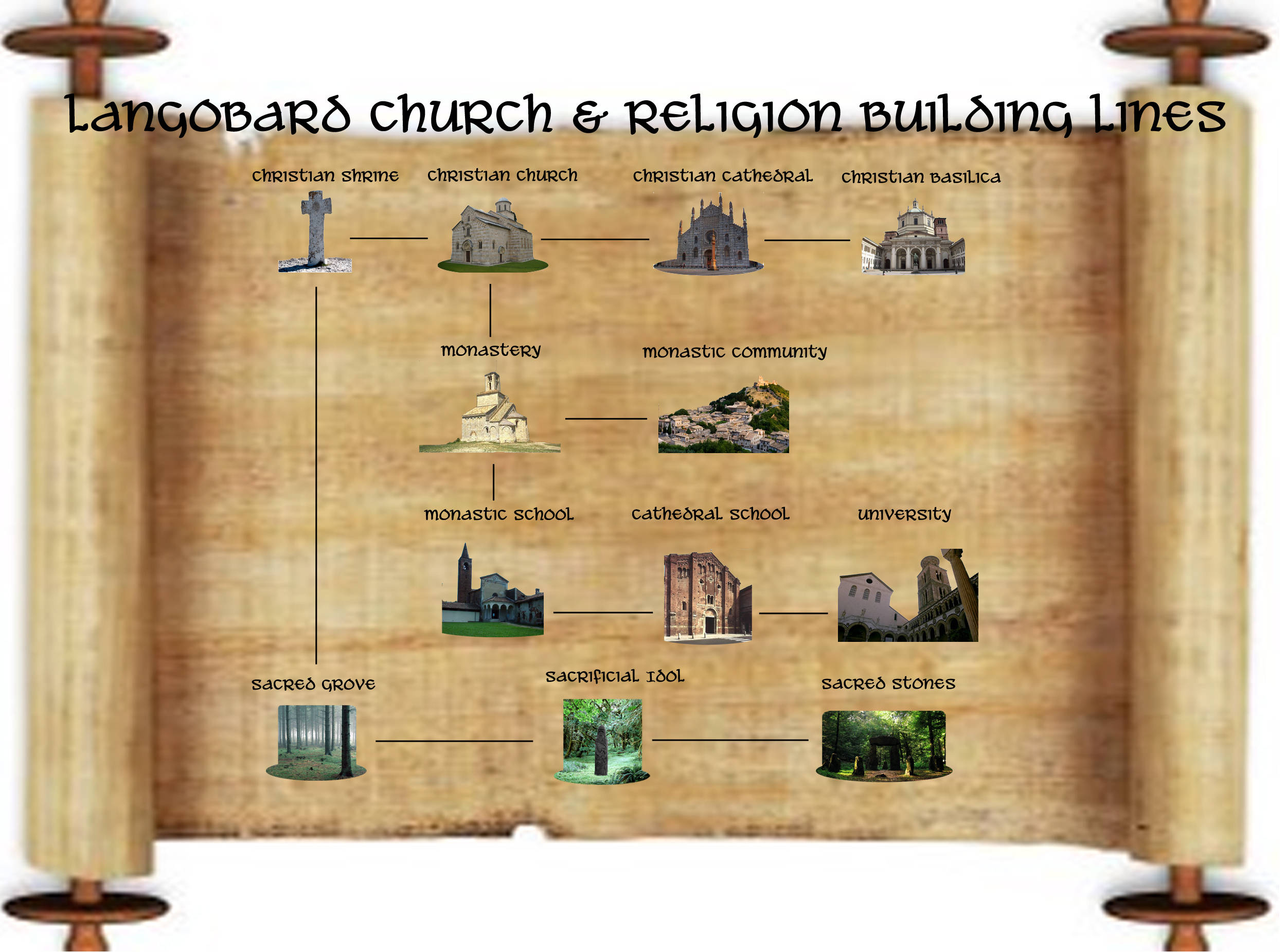The year is 968 C.E. Welcome to the dawn of kingdoms. The past few centuries have been dark and full of corruption, evil and greed. After the Roman Empire fell in the West, chaos ran rampant as Germanic tribes began to take what they could of the Roman lands and create their own tribal kingdoms all over Europe. These kingdoms have been solidified and now many great leaders are at their helms. However, the threat of the Vikingar has long been looming, and their armies have slowly shifted from raiding warbands to full blown armies. Each kingdom must beware of their armies, for they are a force to be reckoned with. The Muslims from the South and the East are slowly encroaching upon Christian Europe as well; their armies are strong and their culture is advanced, and must be feared as well. The "Heiðinn Veðr" is coming, and must be defended against - for the good of the people of Europe.
Hello!
Its time for another preview. Actually its oldest preview ready, but i had few problems with posting it in past, also my web was glogged up for a while, so basically excuses, excuses.
In any case, i apologise for keeping you waiting for so long.
Be warned though- i bring to you whole review this time not just faction history.
Also, Heiðinn Veðr is still recruiting. for further info, please head ask Heathen storm or head to forums (http://www.twcenter.net/forums/forumdisplay.php?1925-Heiðinn-Veðr-Total-War-(HV-TW) )
And dont forget to vote for us in Mod of the year competition :)
But here it is:
Principality of the Langobards

Origins
The origins of the Lombard tribes are shrouded in the mists of history and legend. They came into being long before Christ walked the earth, in the frozen lands of Scandinavia. Next to nothing is known about where their tribe originated, although there are some speculations. Their tribe was originally called the Winnili. The Winnili soon became too overpopulated for their lands, and so a group of them split from the main tribe to settle elsewhere. They crossed the Baltic sea, and landed in the lands of Scoringa, along the Baltic coast. These lands were rich, but they were ruled by a powerful tribe called the Vandali. The chieftain-brothers of the Vandali, Ambri and Assi, gave the Winnili the choice of tribute or war. The young Wilinni chieftains, Ybor and Aio, refused to pay tribute. The Vandals consulted Oðhinn, the Allfather, and asked who would win the battle. Oðhinn answered that the first tribe he saw at sunrise would be victorious. Gambara, mother of the Winnili chieftains, consulted Frigg, Oðhinn's wife. Frigg told her to gather all the women of the tribe, and tie their hair under their chins like beards. So, the women of the Winnili accompanied their husbands to the battlefield at sunrise, and Oðhinn saw them first. He asked his wife, "Who are these long-beards?" Frigg replied, "My lord, thou hast given them the name, now give them also the victory."
And so, the tribe known as the Langobards were born. According to the Roman historian-senator Tacitus, the Langobards moved their tribe near to the mouth of the river Elbe. There, they became part of the Suebian confederation. They slowly increased their lands as the centuries progressed, until suddenly in 17 AD war broke out. The Cherusci, Semnones, and Langobards revolted against the Marcomanni king Marobad. Over the next century, the Langobards were quiet and relatively unmentioned. Then, right before the Marcomannic Wars in AD 166, the Langobards invaded the area of Pannonia. However, they were soundly defeated and fled deep into Germania. They remained hidden in the dark forests for over three centuries, until the second half of the fourth century - when they embarked on a migration to a new land. Near the year 500, they reached the lands of Vurgundaib, the lands of the Burgundians. Here, they were attacked by the Huns, where their first king Agelmund was slain. One of their nobles, Laimicho, was raised as King. He led the Lombards against the Huns to avenge Agelmund, and slaughtered them. Soon, a new King named Audoin led them into Pannonia as foederati of the Roman Empire.
His successor, Alboin, was energetic and and powerful. He defeated and subjugated the Gepidae, a neighboring tribe, and married their king's daughter Rosamund. In 568, Alboin led his tribe along with some members of the Saxons, Bavarians, Gepidae, and Bulgars into the lands of Italy. The first city to fall was Forum Iulii. Next, the cities of Vicenza, Verona and Brescia fell into the Langobardi hands. In 569, Alboin conquered Milan and went on to siege the city of Pavia. In 572, Pavia fell and became the first capital of the newly established Kingdom of the Langobards. However, Alboin did not live to continue his invasion. After Pavia became his capital, his wife Rosamund and some of her old tribe's warriors assassinated King Alboin. His successor, Cleph, forced Rosamund to flee to the city of Ravenna, then ruled by the Roman Empire. Cleph continued on to conquer the region of Tuscany, and even brought his armies to the gates of Ravenna - but was slain by a slave before he could take the city.
The period after Cleph's death is known as Rule of the Dukes, because none had true authority. However, in 585, Cleph's son Agilolf took the throne. He spent much of his reign fighting the Franks to the north, and the Romans to the south. He also battled a rebel Langobard duke who allied himself to the Romans. He swept through the entire peninsula of Italy, taking all of the lands except for those ruled by the Papacy and the region of Calabria. When he died, his relative Agilulf was raised on the shields as king, and he married Agilolf's widow to legitimize his reign. Pressured by his new wife, he converted to Catholicism, and his kingdom followed suit. He was crowned rex totius Italiae, meaning "king of all Italy." He was a strong ruler, and due to civil war in the Frankish kingdom, he was able to focus all of his energy on fighting the Romans. He died in 616, after more than twenty-five years on the throne.

Decline and Fragmentation of the Kingdom
Adaloald, Agilolf's son, became king as a very young boy. However, he went insane and was deposed by Agilolf's son-in-law Arioald. Arioald reestablished Arian Christianity to the Kingdom of the Langobards, a policy that would stay for several generations. After Arioald's death in 636, a young, energetic duke named Rothari came to the throne. Not much was known of his long rule, but he became the first Langobardic king to codify the Langobardic laws in writing, in the Edictum Rothari. A man named Rodoald became king after Rothari, however he was murdered less than six months later. The Catholic Church supported a man named Aribert, who was a Catholic - and was a relative to the Bavarian dukes to the north. He spread his faith amongst the people and built many churches throughout Italy. However, when he died he used a Frankish practice that fragmented kingdoms - he left his lands to both of his two sons. One was assassinated by the Duke of Benevento, Grimoald, and the other was exiled from Langobardia by the same man. Grimoald ascended the throne for himself, and married their sister to legitimize his claim to the throne. He was a great king, known for his generosity, mercy and his strength in warfare. He died in 671, and was succeeded by the man he exiled, Perctarit. After a relatively uneventful reign, Perctarit's son Cunipert succeeded him. The southern duchies of Benevento, Spoleto, Solerno, and Capua grew largely autonomous until they no longer answered to the King. Cunipert's reign was turbulent, and filled with rebellions. After Cunipert died, various kings passed through the throne, but none stayed on it for long. Few are worthy of mention, as most only ruled for a period less than ten years. However, King Liutprand showed that he was worthy of the title "king". He conquered Bologna, Osimo, Rimini, Ancona, Emilia, and the Pentapolis. Ravenna was given to him after its exarch Paul died. He signed a twenty year peace treaty with the Papacy, and returned Ravenna to them.

When he died, the throne continued to be passed on to useless and incompetent kings, until it arrived at Desiderius, the last king of the Langobards. Desiderius attacked the Papacy, laying siege to Rome, and threatened to destroy them. However, because of the close ties between the great Charlemagne and the Pope, Charlemagne invaded Italy and destroyed the Kingdom. The Southern duchies continued to exist without being ruled by the Carolingian Empire, and would continue for the next three centuries.

Carolingian Rule and the Langobard Duchies
While the Carolingian Empire dominated the lands of the Kingdom of the Langobards, their iron fist couldn't reach the Langobard duchies that remained in the southern half of the peninsula. From the late 700's to about 900 A.D., the duchies were reduced to squabbling, power-hungry dukes attempting to recreate the kingdom. This all changed, however, in 900 A.D. Atenulf of Capua conquered the rival duchy of Benevento, which was under Roman rule, and so united the households under one. His son Landulf succeeded him, and after that his son Landulf II succeeded the first. After Landulf II died, a man named Pandulf became sole prince of Benevento and Capua.
Pandulf Ironhead
The first few years of Pandulf's reign was fairly uneventful. After the previous duke of Spoleto had died, the German Emperor Otto I (known as the Great) came to Benevento, and bestowed the duchy of Spoleto to Pandulf. His only condition; fight the Eastern Roman Empire. A joint force of Germans and Langobards sieged the Roman city of Bari in early 968. Here is where your story begins.
Starting provinces
Society and Culture
The Langobardic society was stratified - one of the few traditions that they inherited from their Germanic origins. They were made up of the Faramanni (also known as the Minores), or the poor, lower class men; the Arimanni, free men, who could vote in the Gairethinx; the Sequentes, the retainers, who served a lord for food, land and pay; and the Maiores, also known as the vassali, who were directly paid from a prince or duke, and obtained their equipment from their lord.
Religion was a very complex issue in the Langobardic lands. The Kings and Princes often shifted between Germanic Christianity, Arian Christianity, and Catholicism. The Pope often involved himself with the struggles of the Langobards to elevate a Catholic ruler to the throne, although he failed more often than not.
In the southern duchies, the Langobardi developed their own unique Christian rite. Many still practiced ancient pagan rituals incorporated with Christianity, like performing a sacrifice in sacred groves or forests. However, a small amount of the Langobard population remained pagan, although most of which were nominally Christian. As such, the Langobardi will have a very unique religious system.
The first religious building line available for the Langobards is the church line. Churches provide general happiness to the population. They can also store large amounts of grain to feed the community, and trade fairs often are started around churches.
Buildings: Christian Shrine -> Christian Church -> Christian Cathedral -> Christian Basilica
Bonuses: 5% happiness bonus, chance to convert characters -> 10% happiness bonus, chance to convert characters, 5% public health bonus -> 15% happiness bonus, chance to convert, 5% public health bonus, trade increase -> 20% happiness bonus, chance to convert, 10% public health bonus, trade increase
One a church is built, the player can then build the monastery building line. Monasteries make the people feel more in-tune with God due to their holy population. However, monasteries can often be targeted by bandit raids. They also decrease the population by taking out male members and forcing them to not reproduce. Monks often make crafts and sell them, giving a large boost to the economy.
Buildings: Monastery -> Monastic communities
Bonuses: 10% happiness bonus, -0.5% population growth, increase in trade, -5% law bonus -> 15% happiness bonus, -1.0% population growth, large increase in trade
The monastery will unlock another building line, the Education line, which is one of Heiðinn Veðr's new and (semi-)unique ideas to increase immersion. In medieval times the only form of schooling was that of a monastic school (taught by monks in a monastery). These would later evolve into Cathedral Schools and then the later medieval University.
Buildings: Monastic School -> Cathedral School -> University*
Bonuses: 5% happiness bonus, can further education and hone skills -> 5% happiness, can hone skills even more -> 5% happiness, can master skills
*Even though the first university was founded in 1088 (the University of Bologna), the team and I believe that we should allow the player to really influence how history will go. Besides, our time period does overlap with the start of universities, after all 
The Christian Shrine will also unlock another building tier... This one, however, could be a real game-changer. This is the Sacred Grove line. These represent the "sacred groves" where some of the Christians and the pagans would go to sacrifice to whichever god(s) they believed in.
Buildings: Sacred Grove -> Sacrificial Idol -> Sacred Stones
Bonuses: 5% happiness bonus, 10% law bonus, chance of conversion to paganism -> 10% happiness bonus, 15% law bonus, -30% happiness if Christian Church present, chance of conversion, unlocks "religious tolerance" event -> 20% law bonus, 10% happiness bonus, chance of conversion
After building the Sacrificial Idol, a yes/no event will pop up asking if you wish to allow religious tolerance in your kingdom. This is a very important, game changing decision to make. Allowing religious freedom will seriously damage your relationship with the Papacy. In fact, it could even throw you into war with the Papacy and some of the Christian nations around you. However, it will give you access to pagan temples which will give very strong bonuses, and if the Papacy declares war on you, you may be free to convert to paganism so you don't have to deal with the Pope any longer. You would gain a substantial happiness bonus in every settlement, of course, since any pagans in your midst would no longer have to hide their religion. Refuse to allow religious tolerance, however, and you may face massive riots in any region with the sacred grove building lines present. Pagan rebels may be present as well, so be warned - civil war may be ignited if your leader is not strong enough to deal with it.
Military Tactics
The Langobard military was quite similar to the mighty Frankish Empire's; however, there were some differences. Through their battles with the Huns and Avars, the Langobardi became more distanced with the infantry tactics of other Germanic tribes and instead focused on a strong cavalry arm. This emphasis on cavalry was then heightened through contact with the (Eastern) Roman Empire, and the nobility became increasingly heavily armored horsemen. All who could afford a horse (The Maiores and were expected to use it in war. Those who could not afford a horse (The Minores) were expected to own a bow and be proficient in its use. The main formation of infantry was to provide cover fire for the cavalry arm. However, if the terrain was rough, or in the case of a siege, some of the heavier armored nobles and cavalrymen would've gladly dismounted, returning to their Germanic roots.
Pictures of troops are uploaded into gallery.
CREDITS GO TO:
Absinthia for his excellent unit bases, models and textures
Rusichi: TW team for their excellent horses and some textures
Lord_Calidor for his great weapon models
Also, I would like to give a HUGE THANK YOU to Diocle, who was a massive help to the team in the making of this faction
Hope you all enjoy!
(this preview was copied from Twcenter.net with permission of mod owner)

Heiðinn Veðr wants you!
NewsGot any skills that might help mod? Then please contact us and help to get this mod done faster!




















This comment is currently awaiting admin approval, join now to view.
It's an outstanding mod! Don't waste all the work you already did...please, save it! Or try to pass it to other modders...good luck.
Agreed, those unit models could have been great in Wrath of the Norsemen.
Noooo don't let this mod die:(((( the previews and faction list are OUTSTANDING! Creator, try to save it :D
Is dead? D:
Is this still alive?
I was asking myself the same thing
Sorry for late reply
To be fair, i dont think its gonna be out anytime soon as mod leader (who is also main modder) is extremely busy with real life.
This comment is currently awaiting admin approval, join now to view.
C.E? Whats that supposed to mean?
Its supposed to mean Common Era, Christian Era or Current era. its basically same as AD